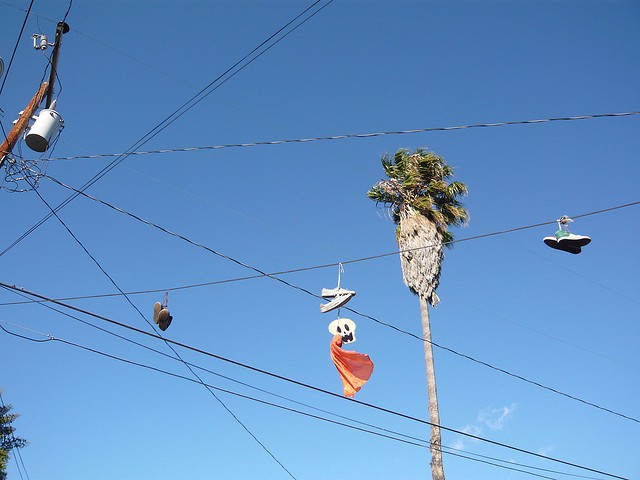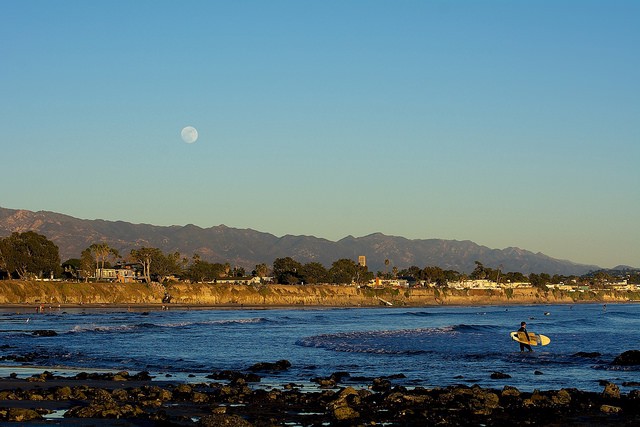A Morning in Isla Vista
A Morning in Isla Vista

I don’t remember much about that first time I drove through Isla Vista, except that it wasn’t what I had expected. Our parents told us that it had a higher rate of STDs than anywhere else in the country, and that it accounted for one percent of all alcohol consumed in the U.S. Isla Vista, just a dozen exits north on the 101 — a shorthand for danger and debauchery. But it was just beachy and grimy, pleasant and closer to whatever I imagined the real world was supposed to be like. There were palms and eucalyptus trees, and I saw a passed out man face down on a beat-up couch near the sidewalk.
A few weeks ago, I went back. I was supposed to meet a scientist at UCSB. The day we had decided to meet turned out to be a week-and-a-half after a man, a little older than I had been when I first drove up the coast, shot and stabbed 13 people before turning his gun on himself. After the killings, the scientist pushed our long-scheduled morning meeting back into afternoon. “Here trying to figure out what happened last weekend…” he wrote. With that morning free, I found myself wandering around Isla Vista again.
I drove down Camino del Sur, behind two women with blonde hair and long limbs, beautiful in a casual way, on cruiser bikes pedalling slowly side by side, taking up the whole lane — a too-perfect symbol of coastal California. They were chatting, and I watched one lean back and let out a huge laugh. This is where Gwyneth Paltrow went to school, where reality television producers for dating shows scout for contestants among I.V.’s — everyone here calls it “I.V.” — 20,000 residents, always young, always new, year after year.
After parking, I walked toward Del Playa Drive and, as the name suggests, the ocean. I turned on Sabado Tarde Road, where Elliot Rodger shot and wounded three, then struck two skateboarders with his BMW and shot another. As Rodger fled down Sabado Tarde, he exchanged gunfire with county sheriffs, just a stone’s throw from Little Acorn Park, where a mosaic of sunflowers stands as a memorial to the four victims of another vehicular rampage, back in 2001. Del Playa was quiet. Sabado Tarde was, too. A few bikers. A skateboarder. An old, scruffy man in army fatigues standing silently in the shade of an electric pole. What is it I hoped to see? Someone threw flower petals at the foot of the building with bullet holes. A banner said, “What we do now is up to us.”
I walked to the Embarcadero de Mar, which curves around another little park, to Freebirds, a burrito franchise that started here, but is very popular throughout Texas. Outside, more bikes, parked along the sidewalk, students splayed over wooden tables in the sunshine, a breeze off the Pacific. I approached four students, and asked them if they could talk for just a second. “I’m a reporter,” I said. “Who are you with?” one of the guys asked. I told him the name of the publication that had paid for me to be there to meet the scientist that afternoon. I said I grew up down the coast and then something like, “I don’t think I’ve ever understood I.V. You probably can’t unless you live here.”
“That’s right, that’s right,” another guy, in Vans slip ons, said. He said that after the killings there had been a memorial paddle out. Surfers, and a lot of other people too, waded into the sea and sat up on their boards, grasping their neighbors’ hands while watching the setting sun. He said exactly the words a person thinks he or she should say to the media, all the words that aren’t ugly or exact. He never said “stab” or “shoot” or “kill.” The “tragedy” had its “victims,” the community had “rallied,” and “would be made stronger for it.” For a moment, I felt like we were actors. I was playing the role of the dutiful reporter, nodding sympathetically, taking down bits of what he told me in my notebook, while he described the feelings he was supposed to feel in the order he was supposed to feel them. Sadness, followed by fortitude.

Inside of Freebirds, I got a burrito and found a copy of the Santa Barbara Independent, the alt-weekly where I’d worked for two summers. In it, a student, Hannah Mendoza, had written an essay about I.V. She’d come here from England. “The kindness of this community astounded me…It took me from a scared, lonely freshman thousands of miles away from home to a passionate advocate for our little town and all its beauty.” I wrote down the headline: “Collective Heartbeat in Isla Vista Strengthens.” There were bleaker outlooks, too. My old boss, Nick Welsh, wrote in his column, “Angry Poodle Barbecue,” that the unincorporated I.V. was “a bastard stepchild of a town disowned and disinherited by any and all responsible parties.” There had been “two riots in five months. Two gang rapes,” he wrote. “I don’t know…maybe somebody should do something.” A different article had the aside: “It’s important to note that Isla Vista is a community that sucks residents in and spits them out just a few years later.”
Near the end of Mendoza’s essay she had written, “To the outside world, we are a town of riots, tear gas, beached bodies, and binge drinking. We seem the perfect paradox: a coastal paradise plucked straight from a movie set yet marred with the crime rate of an inner-city ghetto.” And yet, “Days after the event that shook our town, a sense of frailty still fills the air, but it is tinged with something else, too. Now, words seem gentler, the smiles longer, the embraces tighter.”
After my burrito, it was time for the meeting, so I found my car and drove across campus. I waited outside the scientist’s office in the shade until the ocean breeze chilled me into moving into the sunlight. He arrived and we had our chat. At the very end, I asked him how he was doing — how the campus was holding up. He paused and took a deep breath. “It’s just that…” he said. Then another breath. “Just that no one can imagine such a thing happening here, in such a place.” Another pause. “You know, two of the girls were in that sorority, they were friends with the girls who died, and they came to class and seemed…” his eyes welled up, then he looked up at the ceiling and said, “I think there’s been some healing, and there will be a lot more. But everyone’s shell-shocked, you know? That this could happen here, where it’s so nice, where it’s so beautiful.”
On the way back to my rental car, I squinted out at the paddle boarders beyond the kelp paddies and noticed the water boiling — small fins breaking through the light chop: a pod of porpoise, moving east along the coastline and out to sea. I watched them until I could no longer see fins. In the car, I heard the NPR news reader announce that there had been shootings at Seattle Pacific University. Police were in pursuit of a gunman. I pulled over and checked Twitter for any scrap of information. When I couldn’t find any new news, and NPR broke to a different segment, I changed the station to 91.9, the campus radio, KCSB. An old Isley Brothers tune, “Put Yourself in My Place” was on: Put yourself in my place/ If only for a day/See if you can stand/The awful emptiness/I feel inside. I imagined, now, a great sweeping wave that was outrage. Then another wave — sadness. And another — despair. Wave after wave pounding up against the shore, across the continent, the ocean sucking in and spitting out new horrors for the next day, and the next day, and the next.
After the Isleys, Nina Simone came on. “Feeling Good.” I listened to the way she told the birds, and the breeze, and the fish, and the river that they all know how she feels. It sounded so mournful, then the brass came in sinister, in that minor key. Near the end, Nina shouted “freedom is mine, and I know how I feel” and it sounded like a taunt. I waited until the song was over and as I started the car, I heard the deejay say, “That’s it for me.” Her voice was young — a student, almost certainly. “See you in the fall,” she said. Then: “And have a great summer.”
Ryan Bradley is a writer and editor in New York for a little while longer.
Photos by Ryosuke Yagi and Glenn Beltz, respectively
